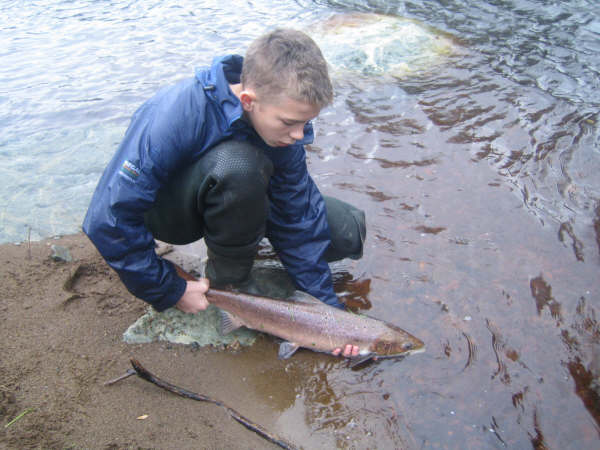Catch and Release
Catch and release is a hot topic among anglers.
The Moyola Angling Association have debated this issue over many long hours, and have introduced Catch ad Release for Salmon this year,Also any dollaghan over 3lbs must be returned during the month of October..2018
There can be no doubt that every hen salmon released will help bolster our future salmon stocks, although some may argue that returned fish are less likely to survive to spawning. Please leave your comments and thoughts on the guestbook...
Salmon conservation is about education, and while there is still much to be learned, one young angler from Draperstown has set a shining example for other anglers young and old.

Michael O'Kane is seen here releasing his salmon back into the Moyola, where he hopes it will go on to produce thousands of eggs and complete its life-cycle in the streamy water above Draperstown.
Guidelines on releasing salmon...
Playing the Fish
Playing a fish in the following way will help its chances of survival:
Playing a fish in the following way will help its chances of survival:
1. Avoid exhausting the fish
2. In a river, move the salmon out of the fast current into quieter water
3. Once the fish is subdued bring it quickly to the bank or boat
2. In a river, move the salmon out of the fast current into quieter water
3. Once the fish is subdued bring it quickly to the bank or boat
Landing the Fish
Research has shown that exposing a salmon to air for even a short period, for example to take a photograph, can significantly reduce its chances of survival.
Research has shown that exposing a salmon to air for even a short period, for example to take a photograph, can significantly reduce its chances of survival.
1. Keep the salmon in the water at all times.
2. Use a large diatmeter landing net with soft knotless mesh.
3. Avoid beaching the fish
4. No gaffs or tailers.
5. Always handle the salmon with wet hands
2. Use a large diatmeter landing net with soft knotless mesh.
3. Avoid beaching the fish
4. No gaffs or tailers.
5. Always handle the salmon with wet hands
1. Wet your hands and keep the fish in the water Handling of the fish should be minimized.
2. When necessary the fish should be supported from beneath and the hook gently removed either by hand or by means of long-nosed forceps.
3.I f a hook is deeply embedded and cannot be removed, the leader should be cut close to the hook, as fish released with the hook attached will generally survive.
4. Take extra care with fresh fish, as they are more prone to scale loss, injury and subsequent fungal infection.
5. Care must be taken not to squeeze the fish or hold it by the gills.
Releasing and Reviving the Fish
1. After removing the hook or cutting the leader, the fish should be supported in the water facing into the current and given sufficient time to recover.
2. Hold the fish gently until it is capable of swimming away strongly.
3. Avoid weighing the fish.
4. The weight can be estimated from its length using the conversion chart.
5. A tape measure or a wading stick can be used to take the approximate length while keeping the fish in the water.
6. Unless compelled by statutory regulations or local rules, fish that have suffered serious damage (bleeding heavily, hooked in the gills or eyes) should be retained.
2. Hold the fish gently until it is capable of swimming away strongly.
3. Avoid weighing the fish.
4. The weight can be estimated from its length using the conversion chart.
5. A tape measure or a wading stick can be used to take the approximate length while keeping the fish in the water.
6. Unless compelled by statutory regulations or local rules, fish that have suffered serious damage (bleeding heavily, hooked in the gills or eyes) should be retained.
Survival Chances of Released Salmon
1. Research has shown that the survival rate of salmon caught and released can he close to 100% when the above guidelines are followed.
2. Survival rate is greater at water temperatures below 20 C.
3. Very good survival to spawning of released rod-caught spring Salmon, which have subsequently spent up to nine months in the river before spawning, has been recorded in Scotland.
4. Spawning sucess and viability of eggs are unaffected in salmon caught and released in late autumn.
2. Survival rate is greater at water temperatures below 20 C.
3. Very good survival to spawning of released rod-caught spring Salmon, which have subsequently spent up to nine months in the river before spawning, has been recorded in Scotland.
4. Spawning sucess and viability of eggs are unaffected in salmon caught and released in late autumn.

